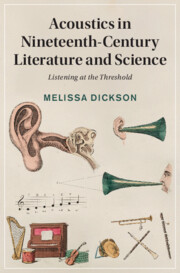Book contents
- Acoustics in Nineteenth-Century Literature and Science
- Cambridge studies in nineteenth-century Literature and culture
- Acoustics in Nineteenth-Century Literature and Science: Listening at the Threshold
- Copyright page
- Contents
- Figures
- Acknowledgements
- Introduction Whispers in the Roar
- Part I
- Chapter 1 Accessing the Sounds of the Body
- Chapter 2 Stethoscopic Fantasies
- Chapter 3 Middlemarch and the Art of Stethoscopic Listening
- Part II
- Part III
- Part IV
- Conclusion
- Notes
- Select Bibliography
- Index
- Cambridge studies in nineteenth-century Literature and culture
Chapter 2 - Stethoscopic Fantasies
from Part I
Published online by Cambridge University Press: 13 December 2024
- Acoustics in Nineteenth-Century Literature and Science
- Cambridge studies in nineteenth-century Literature and culture
- Acoustics in Nineteenth-Century Literature and Science: Listening at the Threshold
- Copyright page
- Contents
- Figures
- Acknowledgements
- Introduction Whispers in the Roar
- Part I
- Chapter 1 Accessing the Sounds of the Body
- Chapter 2 Stethoscopic Fantasies
- Chapter 3 Middlemarch and the Art of Stethoscopic Listening
- Part II
- Part III
- Part IV
- Conclusion
- Notes
- Select Bibliography
- Index
- Cambridge studies in nineteenth-century Literature and culture
Summary
Chapter 2 turns to the presence of the stethoscope in medical consultations from the perspective of the newly objectified patient, now acutely aware of, yet unable to hear or to interpret, the sounds of their own body. Horror, dread, and insight into the unknown are staples of the Victorian sensation and gothic genres, which, I argue, provided an anxious site for the medical and the imaginative to inform and disrupt one another in fictional explorations of the powers of the stethoscope. Drawing on works by Wilkie Collins, Bram Stoker, Mary Elizabeth Braddon, and Sheridan Le Fanu, as well as short stories and poetry from popular periodicals, this chapter demonstrates that, as medical institutions accepted new technologies and became increasingly specialised throughout the century, the stethoscope became for many patients an object of anxious contemplation, serving as a palpable interface between doctor and patient, between hope and fear, and between the visible and invisible.
Keywords
- Type
- Chapter
- Information
- Acoustics in Nineteenth-Century Literature and ScienceListening at the Threshold, pp. 39 - 56Publisher: Cambridge University PressPrint publication year: 2024

